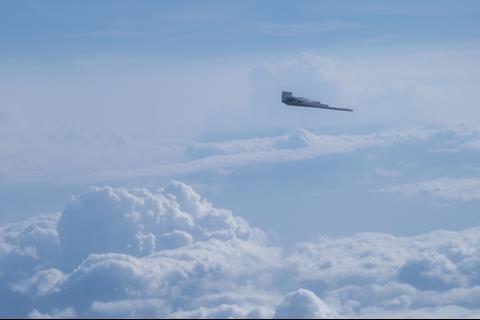The US Air Force (USAF) has flown a Northrop Grumman B-2 Spirit stealth bomber through the Arctic Circle, from Iceland to Alaska, to participate in air combat drills.
Three of the nuclear-capable flying-wing aircraft have been forward-deployed in Iceland as part of a NATO deterrence mission. Although the bombers only just arrived in Europe on 13 August, the USAF has already returned one to North America, temporarily.
“On 15 August, the B-2 that flew to Alaska participated in the Red Flag-Alaska [exercises], to engage in training scenarios within the expansive Joint Pacific Alaska Range Complex,” the USAF command overseeing Europe and Africa told FlightGlobal on 23 August.
US Air Forces in Europe (USAFE) on 17 August released photos of the B-2 Arctic flight on the social media platform X. Red Flag exercises are large combat drills organised by the USAF that can include up to 100 aircraft and 1,500 personnel.
The B-2 accomplished its trans-Arctic flight with support from Boeing KC-46 and KC-135 tanker aircraft, according to USAFE, before returning to Iceland for the ongoing NATO mission.
“Each bomber task-force mission underscores the prowess of our armed forces in navigating today’s intricate and unpredictable global security terrain, with a focus on fostering stability, security and freedom across Europe,” says General James Hecker, the top USAF commander for Europe and Africa.
The USAF began holding Red Flag air combat exercises in 1975 at Nellis AFB in Nevada. The service typically holds three iterations annually of the multi-week drill, covering disciplines including air-to-air combat, aerial refuelling and ground-based logistics.
Aircraft of all types from the USAF and allies globally rotate through Red Flag exercises. The Alaska-based Red Flag is hosted by the USAF’s Pacific headquarters, which has run the drills from Eielson AFB since 1992.
“Red Flag Alaska stands as a top platform facilitating international collaboration, a pivotal element contributing to the accomplishment of air operations’ objectives,” USAFE says.




























